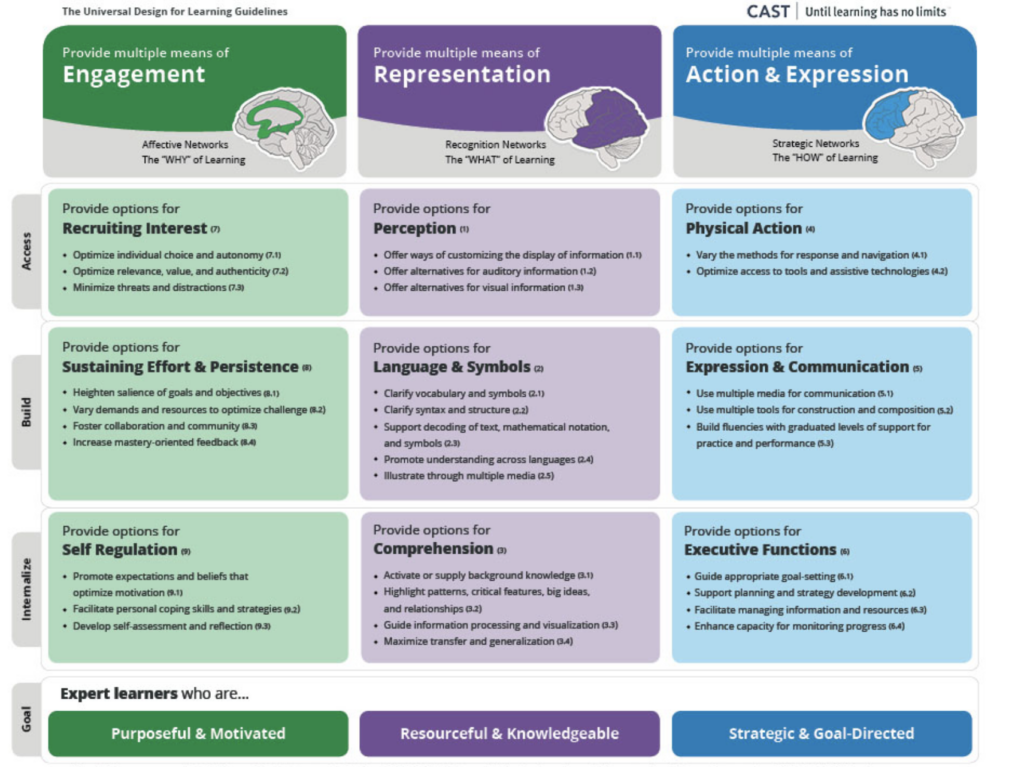Universal Design for learning also known as UDL

This week’s resources focused on accessibility and inclusion of educational teaching methods. For my reflection I chose to focus on the article about universal design for learning also known as UDL. UDL is a teaching framework that provides guidelines for teachers to follow in order to create the most effective learning environment for all types of learners.
While watching the videos provided in this resource, it made me reflect on my own experience. The video talked about how all students come from different backgrounds with different abilities and how important it is that no matter our differences, we all deserve the same opportunities as each other, specifically in our learning environments. This way of teaching is not a perspective or a ‘checklist’ of things a teacher needs to include in their teaching but rather an understanding of how to make their learning environment beneficial to all students and give everyone equal opportunities to learn!
In my own experience, during practicum I worked with a wide range of learners. I taught in a grade one classroom with 6 grade 2 students, all of the students had a variety of learning abilities and needs! I had a grade 2 student that was taken out of his learning environment due to a family need for over 6 months of the school year! This was very difficult for both the student himself along with the teacher who was constantly needing to accommodate him and his needs. UDL is a framework that helped guide the teacher through challenges like these, helping the teacher find ways to help each student in ways that suit them.
UDL is a framework that provides guidelines for teacher by sharing materials like instructional goals, methods and assessments that work for everyone. This framework takes into account the wide range of different abilities and provides materials that suites everyone. UDL is not a one size fits all solution, it is rather an approach that can be adjusted for each individuals needs
UDL is what makes all students feel equal and encourages students to be themselves as well as work to the best of their ability! While looking more into UDL I found a website that provides examples of when this framework is beneficial in an educational environment. The website I found was posted on a website called, Reading Rockets! This website also provides a place for other resources that assist in literacy, reading and writing.
This quote stood out to me because it is important to start with being able to reach the students you are trying to teach. As shown in the photo blow, there are three principles that guide UDL. Using these principles in your teachings will help reach the students where they are at. Once you have reached them, the teaching can begin!
The principles of UDL ~

Starting with the Engagement Principle- This is the why of learning! This principle is the inner motivation that captures the interest of the students. Egegment often comes with the learning of why they are learning what they are learning with reference to real life examples.
Moving onto the Representation Principle- This is the what of learning! This principle is what allows students to work with material in the way that works best for them. This requires the flexibility of customizing lessons and providing multiple ways to interact with material. Accessibility is essential in this principle, allowing all students the ability to work on what is being taught in a way that works for them (visual, auditorial etc).
Lastly, the Action and Expression Principle- This is the how of learning! This principle is what demonstrates the students learning. Again flexibility is important as students express themselves best in a different ways. This principle also takes on the idea of goal setting, guiding students to monitor their own progress.

Leave a Reply